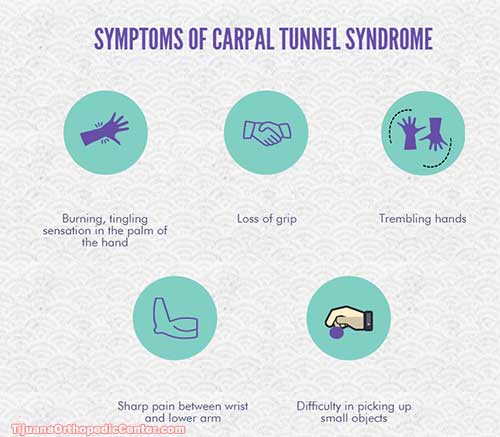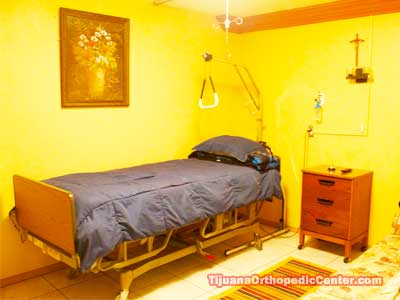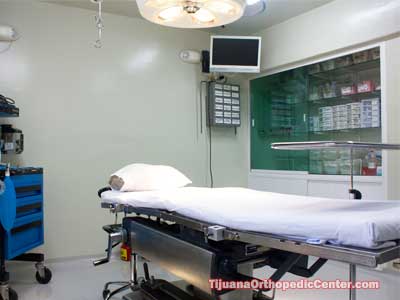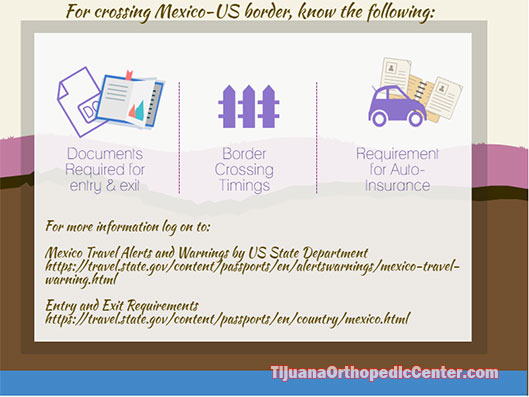Only $2800 for Carpal Tunnel Surgery in Tijuana, Mexico
Fill quote form for more details. Prices may be changed without any prior notification
Median nerve decompression or the carpal tunnel syndrome is a condition which appears when the median nerve running through the tunnel formed by the carpal bones (present at base of our hand) becomes compressed leading to numbness and pain in the wrist. Carpal Tunnel Surgery in Tijuana, Mexico is an affordable alternative for people from the US and Canada to treat decompression of the median nerve.
Our hands are capable of performing diverse functions such as grasping, holding, touching and manipulating. But what happens when we have difficulty performing any of these functions. We feel vulnerable and tend to find fault with our diet and dietary deficiencies. While the reason may be you are suffering from a muscle damage or median nerve decompression.
Why TJ, Baja California for Carpal Tunnel Release?
- The most appealing thing about Tijuana, Mexico is low health care costs. Most Americans face the problem of getting affordable medical services in the US and this is the reason they look down south for solution.
- You can save nearly 70 percent in TJ for your carpal tunnel surgery.
- For people living in San Diego, the convenience of travelling a few miles (just about 17 miles) from there to TJ is another advantage.
TOC for Carpal Tunnel Surgery in Tijuana
Tijuana Orthopedic Center (TOC) is a well-equipped bone and joint surgery center in Baja California which offers advanced orthopedic care at very affordable prices.
Your carpal tunnel surgery in Tijuana will be performed by a well known orthopedic surgeon in Tijuana – Dr. Eliseo Mora Sanchez. With experience of more than 30 years Dr. Eliseo has been a member of the American Academy of Orthopaedic Surgeons (AAOS) for 15 years.
Do I Require a Visa or Passport to Enter Mexico?
If you plan to undertake a trip to Mexico from the USA, you should know the following Entry and Exit Requirements:
| For entering Mexico1, 2 | For re-entering the USA |
| A valid U.S. passport or passport card. | All U.S. citizens traveling outside of the United States by land or sea are required to present a Western Hemisphere Travel Initiative (WHTI) compliant document, such as a passport or a passport card, to return to the United States. |
| An entry permit or Forma Migratoria Multiple (FMM) (when traveling 25 km further into Mexico from the border). | Travelers flying from Mexico to the United States must present a valid U.S. passport. |
| Entry by air, Mexican immigration regulations accept the U.S. passport card. | Children aged 18 and under will need to present a birth certificate, naturalization certificate, or a passport to enter the US. |
| Entering/Exiting Mexico – CANADA | |
| All Canadian citizens need a valid passport to enter Mexico. | |
| Those entering Mexico by plane or land should have A TOURIST CARD stamped at their first port of entry. | |
| Forma Migratoria Multiple (FMM) (for travel beyond the border zone – about 25 km from the border crossing). | |
How can I Stay Safe?
The border crossing at San Diego, California to Tijuana, Mexico, known as the San Ysidro Port of Entry is one of the busiest land border crossings worldwide with thousands of people making their way through it every day. To ensure your safety and security, US State Department has issued Mexico Travel Alerts and Warnings, which you can read here.
Following are some of the travel tips you can pursue for better safekeeping:
- Do not wander alone; shop and stay along with other group members.
- Stay away from gambling and adult entertainment establishments.
- Do not travel after dark.
- Some of the places you may avoid venturing into are the 1st street (Zona Norte) and its most notorious area – Calle Coahuila. Also, you may consider avoiding Tijuana’s east comprising neighborhoods such as El Florido, Murua, Mariano Matamoros, among many others.
How do I Reach Tijuana?
Our Destination Managers can assist you with cross border trip by arranging visa and travel documents.
If you are coming to TJ by air, the closest American airport is the San Diego International Airport (IATA: SAN) and you can reach San Ysidro Port of Entry from there. It is open 24*7.
Alternatively, you can drive in your car and park it at the US side of the border or take along into TJ. For driving into Mexico, it is mandatory to obtain Mexican auto insurance and it can be purchased from both sides of the border or online.
Do You Offer Medical Loans for Orthopedic Surgery in TJ?
Yes, we can get you in touch with a financing company for your carpal tunnel release surgery. Read here for more information. NOTE: We are not responsible for any agreed upon terms and conditions with the financing company.
What is Carpal Tunnel Release?
According to the American College of Rheumatology, carpal tunnel syndrome is the most common nerve disorder which affects nearly 4-10 million Americans. Carpal tunnel syndrome (CTS) is caused by a strained median nerve in your wrist which usually results in tingling, numbness and weakness in your hand. The aim of carpal tunnel surgery is to release the pressure on the median nerve.
Various causes of CTS include3:
- Diabetes
- Hypothyroidism
- Pregnancy
- Gout
- Rheumatoid Arthritis
- Alcoholism
- Trauma to the wrist
- Menopause
What are the symptoms of CTS?
- CTS symptoms usually appear in the morning after a person wakes up, but they can also occur during the night and interrupt the sleep.
- Certain activities such as driving, holding a book with the hands, bending a wrist or grasping activities become tough.
- You may also feel pain and numbness in thumb and first three fingers of your hand
The need for Carpal Tunnel Surgery
If numbness and tingling is mild and occurs periodically, you may not seek medical help. However, the disease can progress to unrelenting numbness and burning in some cases. If this condition is left unattended individuals can experience weakness in hands, sharp shooting pain and loss of sensation in their hand and forearm due to median nerve and muscle damage which requires surgical intervention for CTS.
Surgical treatment of CTS is in the form of a carpal tunnel release (CTR), a procedure in which the transverse carpal ligament (TCL) is cut to augment the space in the carpal tunnel. Approximately 70-90% of patients have good to excellent long-term outcomes following CTR4.
How is CTS identified?
Doctors at Tijuana Orthopedic Center, Mexico can identify CTS using your medical history, physical examination and other tests. A detailed evaluation of your hand, wrist and shoulders is conducted and the doctors will check for causes of nerve pressure.
What is the Procedure of Carpal Tunnel Surgery?
CTS is a less invasive procedure when performed endoscopically than open release. It is usually performed under local anesthesia. The surgeon makes incisions in the wrist and base of the palm and inserts one or two endoscopes. The surgeon cuts the ligament to free the compressed median nerve.
Recovery after Carpal Tunnel Release
According to John Hopkins Medicine, recovery involves splinting your wrist and getting physical therapy to strengthen and heal the wrist and hand. For some patients, release surgery relieves symptoms of numbness and tingling immediately while for others it may take as long as 3-4 weeks.
- Avoid strenuous work right after surgery as it may cause the symptoms to return.
- Peak improvement may take a long time (up to 10 months).
- Extensive physical activities are restricted for 4-6 weeks.
Who is at more risk of developing CTS – men or women?
Clinical data shows that women are more likely to develop carpal tunnel syndrome than men5.
What are the benefits of endoscopically treated CTS?
Endoscopic carpal tunnel release paves a way for quick recovery and return to work. Pain in the scar was less after endoscopic surgery as compared to open carpal tunnel release6.
What precautions should I take post-op?
- Your hand will be bandaged for 1-2 weeks and precautions must be taken to keep it dry.
- Mild swelling is expected. Elevate your hand to decrease swelling and pain. You can also place your arm on a pillow.
- Start with gentle exercises of shoulder and elbow after a week into the surgery.
References:
- https://travel.state.gov/content/passports/en/country/mexico.html
- http://www.canadainternational.gc.ca/mexico-mexique/consul/visas.aspx?lang=eng#Entering
- Aroori S, Spence RA. Carpal tunnel syndrome. The Ulster Medical Journal. 2008;77(1):6-17. http://www.ncbi.nlm.nih.gov/pmc/articles/PMC2397020/
- Carpal Tunnel Syndrome: A Review of the Recent Literature. Inji Ibrahim, Wasim S Khan, Nicholas Goddard, Peter Smitham. The Open Orthopaedics Journal 6(1):69-76 · February 2012. DOI: 10.2174/1874325001206010069. https://www.researchgate.net/publication/223983000_Carpal_Tunnel_Syndrome_A_Review_of_the_Recent_Literature
- Castro, Adham do Amaral e, Skare, Thelma Larocca, Nassif, Paulo Afonso Nunes, Sakuma, Alexandre Kaue, & Barros, Wagner Haese. (2015). Sonographic diagnosis of carpal tunnel syndrome: a study in 200 hospital workers. Radiologia Brasileira, 48(5), 287-291. https://dx.doi.org/10.1590/0100-3984.2014.0069 http://www.scielo.br/scielo.php?script=sci_arttext&pid=S0100-39842015000500287
- Atroshi I, Larsson G-U, Ornstein E, Hofer M, Johnsson R, Ranstam J. Outcomes of endoscopic surgery compared with open surgery for carpal tunnel syndrome among employed patients: randomised controlled trial. BMJ : British Medical Journal. 2006;332(7556):1473. doi:10.1136/bmj.38863.632789.1F. http://www.ncbi.nlm.nih.gov/pmc/articles/PMC1482334/





